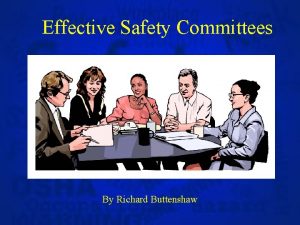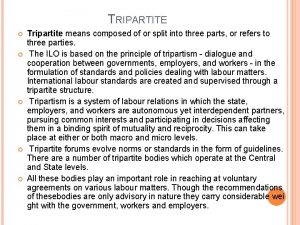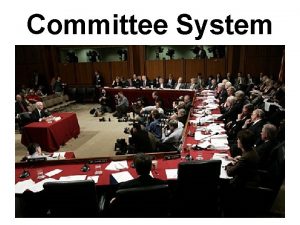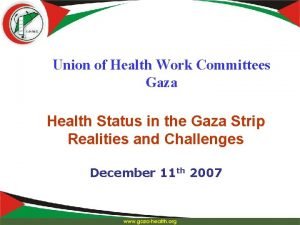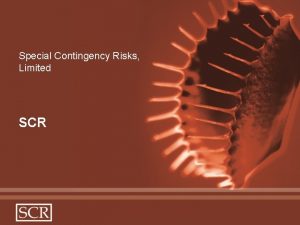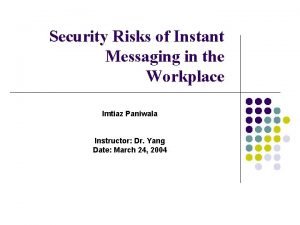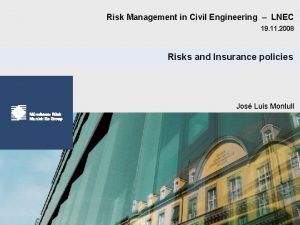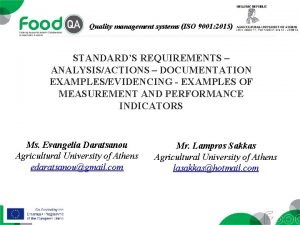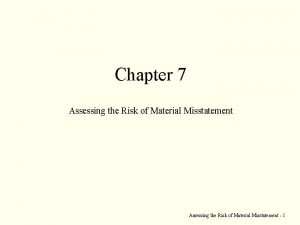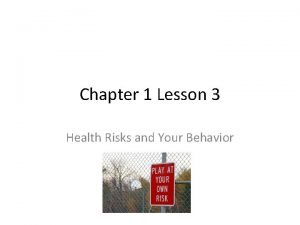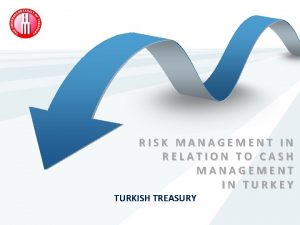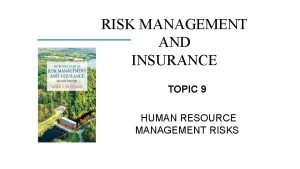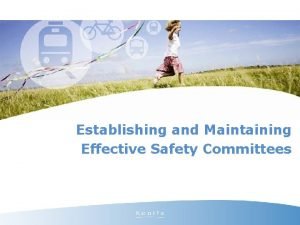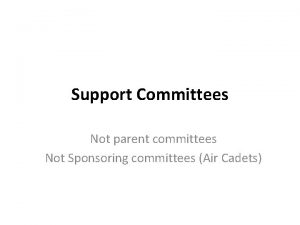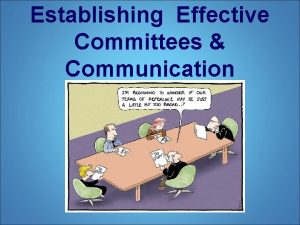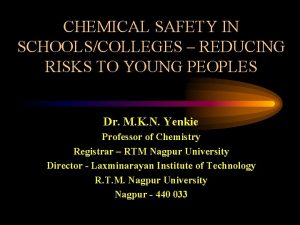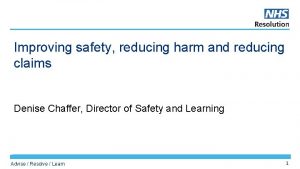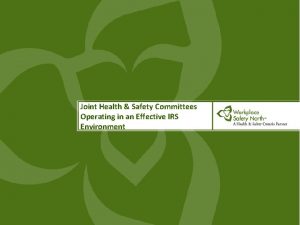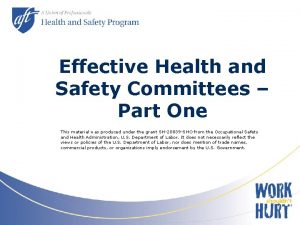REDUCING RISKS THROUGH EFFECTIVE SAFETY COMMITTEES OAMR Conference














































- Slides: 46

REDUCING RISKS THROUGH EFFECTIVE SAFETY COMMITTEES OAMR Conference September 23, 2016 Sharlene P. Stephens Risk Management Specialist City of Ashland

WHY HAVE A SAFETY COMMITTEE? • You care about your employees and want them to work in a safe environment. • You want to reduce or eliminate workplace injuries. • This gives you a way to communicate and evaluate safety and health issues. • A safety committee plays a critical role in maintaining a safe work environment, and it provides a forum for employees to voice their concerns about safety issues.

And…. • You are required to do so by OSHA per its safety committees and safety meetings rule 437 -001 -0765.

WHO IS REQUIRED TO HAVE A SAFETY COMMITTEE? • As a city or county in Oregon, you must have a safety committee or have safety meetings. • If you have 10 or fewer employees, you may have either a safety committee or safety meetings. • If you have more than 10 employees, you probably have to have a safety committee.


WHAT IF YOUR ORGANIZATION HAS MORE THAN ONE LOCATION? • You can have one safety committee or safety meetings at any location that has 10 or fewer employees. • You can also have a centralized safety committee that represents the safety and health concerns of employees at all of the locations. A centralized safety committee must follow the requirements in OSHA’s 437 -001 -0765 rule and represent employees at all of the locations.

CENTRALIZED SAFETY COMMITTEES • An employee from each location does not have to attend a centralized safety committee meeting as long as someone at the meeting represents their interests.

This committee must have a written policy that: • • • States management’s commitment to workplace safety and health. • Describes specific methods for identifying and correcting safety and health hazards at each location. • Requires employee involvement and describes what it means. Describes how management will hold everyone in the organization accountable for safety and health. Requires a comprehensive annual review, in writing, of the committee’s activities to enhance workplace safety at all locations.

WHAT ARE THE OPTIONS FOR FIRE DEPARTMENTS? • Fire departments can have safety committees or safety meetings. Fire departments that have more than one location can have a centralized safety committee that represents the safety and health concerns of employees at all the locations.

WHAT ARE THE REQUIREMENTS FOR SAFETY COMMITTEES? • Membership – Who can be a member? Your safety committee must have an equal number of employer-selected members and employee-elected (or volunteer) members.

• An employer-elected member can be a manager, supervisor, or any other employee management chooses to serve on the committee as its representative. • Employees can elect another employee or supervisor to represent them. • If everyone on the committee agrees, there can be a majority of employee-elected members or volunteers. • Note – Your safety committee must not have a majority of employer-selected members.

Committee duties Members must: Ø Ø Ø Ø Agree on a chairperson. Serve a minimum of one year, when possible. Be compensated at their regular rate of pay. Be trained in accident and incident investigation principles and know how to apply them. Be trained in hazard identification. Receive safety committee meeting minutes. Represent the major activities of the organization.

How many members does your safety committee need? This depends on how many employees your city or county has. ü If you have 20 or fewer employees, your committee must have at least two members. ü If you have more than 20 employees, your committee must have at least four members.

What does your safety committee have to do? 1 – Meet monthly and on company time. Your committee is not required to meet during a month when you perform quarterly workplace inspections. 2 – Keep a record of each meeting. Records must be kept for three years. Your minutes must include:

• Meeting date. • Attendees’ names. • Safety and health issues discussed, including hazards involving tools, equipment, the work environment, and work practices. • Recommendations for correcting hazards and reasonable deadlines for management to respond. • Name of the person who will follow up on the recommendations. • All other committee reports, evaluations, and recommendations.

3 – Have procedures for workplace safety and health inspections. Your safety committee must develop procedures for conducting workplace safety and health inspections that include where the inspections are conducted, who conducts them, and how often.

4 – Accomplish these tasks: • Work with management to establish accident investigation procedures that will identify hazards and ensure that they are corrected. • Establish a system for employees to report hazards to management and suggest how to correct hazards. • Establish a procedure for reviewing inspection reports and making recommendations to management.

• Evaluate all accident and incident investigations and recommend how to prevent them from happening again. • Make safety committee meeting minutes available to all employees for review. • Evaluate how management holds employees accountable for working safely and recommend ways to strengthen accountability. Examples include evaluating the effectiveness of safety incentives, disciplinary policies, and employee participation in identifying hazards.

WHAT ARE THE REQUIREMENTS IF YOU HAVE SAFETY MEETINGS AND NO COMMITTEE? Who Must Attend the Safety Meetings: All available employees must attend safety meetings. At least one person must have management authority to ensure that hazards discussed are corrected. Again, safety meetings must be held on company time and employees must be paid their regular rate of pay.

How often must you meet? If your employees do mostly office work, you must meet at least quarterly, otherwise, meet monthly. What are Safety Meetings Required to Cover: • Discussions of employees’ concerns about workplace safety or health conditions. • Discussions of accident investigations, causes, and suggested corrective measures.

What About Minutes? If your employees do any construction or utility work, you must keep minutes of all safety meetings for three years. If any employee is absent from a meeting, you must keep minutes, so you may just want to make that your standard practice.




WHAT CHARACTERISTICS MAKE UP AN EFFECTIVE SAFETY COMMITTEE? Safety committees with strong and visible upper management support are more likely to make a meaningful impact on workplace safety.

• Committee Size and Structure • Committee Leaders and Member Participation • Management Support • Committees and Safety Culture

QUESTIONS TO BE ADDRESSED BY YOUR SAFETY COMMITTEE Is safety a value of our city/county? How is bad information received? What are the general attitudes toward safety rules, safety committee members, and managers? Is your safety information communicated effectively? Is your safety approach reactive or proactive?

SO WHAT DOES A GREAT SAFETY CULTURE LOOK LIKE? ? ? ?

AND WHAT ARE SOME OF THE PITFALLS TO ACHIEVING A GREAT SAFETY COMMITTEE? ? ? ?






INSPECTIONS


What to look for in an inspection.






What happens to the Inspection Report After it is Reviewed by the Safety Committee?


BOOSTING YOUR SAFETY PROGRAM • Safety Trainings • Incentives

EMPLOYEE EMERGENCY RESPONSE TEAMS (EERTs) OAMR Conference September 23, 2016 Sharlene P. Stephens Risk Management Specialist City of Ashland
 Effective safety committees
Effective safety committees Effective safety committees
Effective safety committees Explain how standing committees function.
Explain how standing committees function. Reducing sugar
Reducing sugar Pyridixine
Pyridixine Molisch test reaction
Molisch test reaction Non reducing sugar vs reducing sugar
Non reducing sugar vs reducing sugar There are....tripartite committees at the national level..
There are....tripartite committees at the national level.. Committees of correspondence
Committees of correspondence Examples of select committees
Examples of select committees The structure of congress lesson 1
The structure of congress lesson 1 Committees of correspondence
Committees of correspondence Health work committees
Health work committees Rotary intercountry committees
Rotary intercountry committees Building customer relationships through effective marketing
Building customer relationships through effective marketing Building customer relationships through effective marketing
Building customer relationships through effective marketing Building customer relationships through effective marketing
Building customer relationships through effective marketing Competing messages communication barriers
Competing messages communication barriers Building customer relationships through effective marketing
Building customer relationships through effective marketing Achieving success through effective business communication
Achieving success through effective business communication Through one man sin entered the world, and through one man
Through one man sin entered the world, and through one man Furcation
Furcation Tangental sawing
Tangental sawing Night of the scorpion by nissim ezekiel
Night of the scorpion by nissim ezekiel The biggest risk is not taking any risk
The biggest risk is not taking any risk Special contingency risks
Special contingency risks David chaffey
David chaffey Risks of e procurement
Risks of e procurement Instant messaging security issues
Instant messaging security issues Civil engineering risk management
Civil engineering risk management Actions to address risks and opportunities
Actions to address risks and opportunities Crl mērījums
Crl mērījums Enterprise risk management framework for credit unions
Enterprise risk management framework for credit unions Risks of bulimia
Risks of bulimia Costs and risks of database approach
Costs and risks of database approach Procurement process cips
Procurement process cips Ar = ir x cr x dr
Ar = ir x cr x dr Chapter 22 lesson 1 the health risks of drug use
Chapter 22 lesson 1 the health risks of drug use Chapter 20 lesson 1
Chapter 20 lesson 1 Types of credit risk
Types of credit risk Chapter 1 lesson 3 health risks and your behavior
Chapter 1 lesson 3 health risks and your behavior Cloud computing benefits and risks
Cloud computing benefits and risks Risk of material misstatement table
Risk of material misstatement table Chapter 1 lesson 3 health risks and your behavior
Chapter 1 lesson 3 health risks and your behavior Owasp top 10 privacy risks
Owasp top 10 privacy risks Cash management risks
Cash management risks Marius meyer missing
Marius meyer missing
